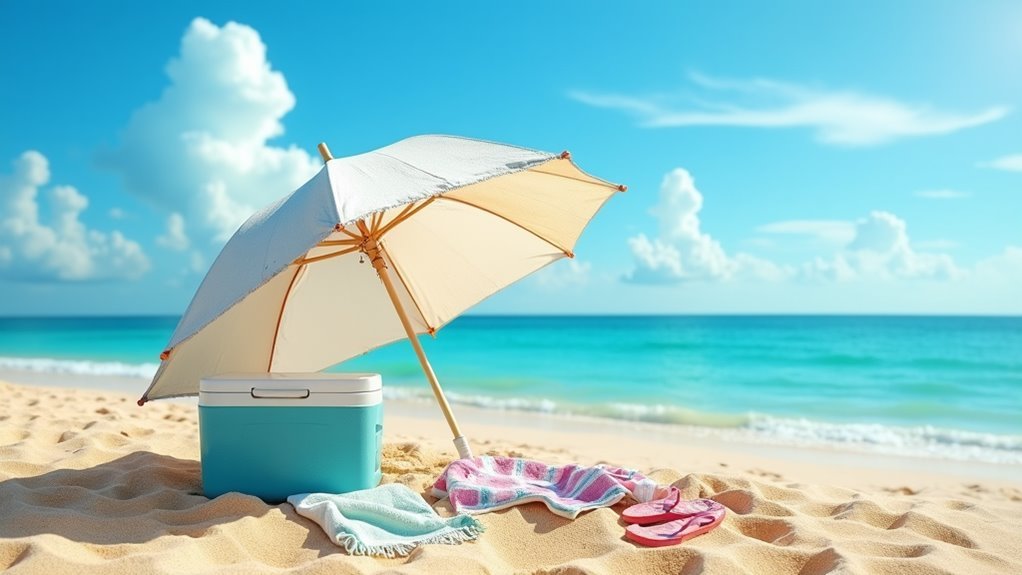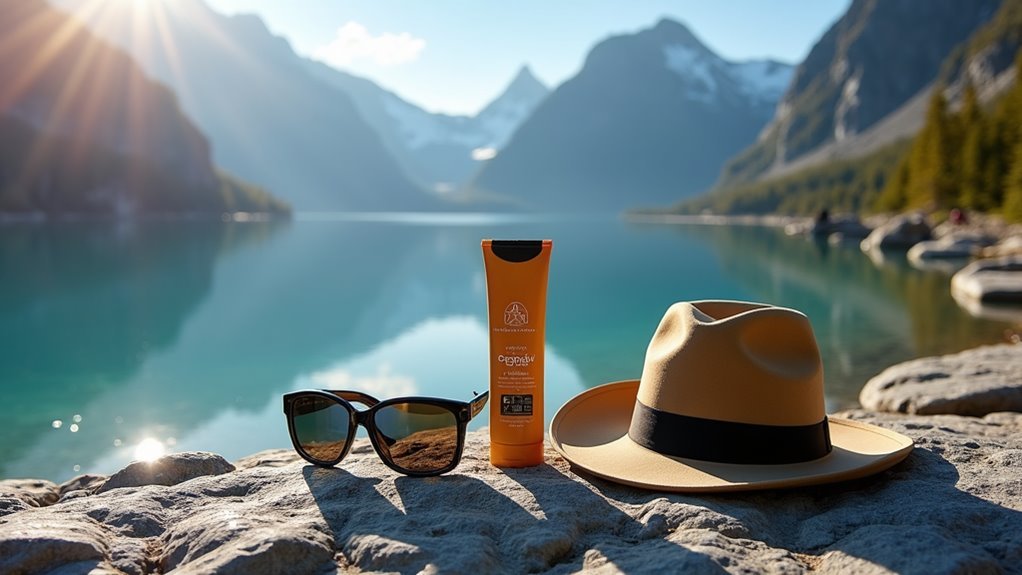I’ve learned the hard way that UV rays silently destroy beach gear—my phone case bleached white after one summer, and I think my sunglasses became noticeably brittle. You need a backpack with UPF 30+ rating and treated fabric containing titanium dioxide or zinc oxide for real protection. Dense weave construction matters too, perhaps more than you’d expect. Dark colors naturally block more radiation, though maintenance gets tricky. There’s more to reflect upon when selecting the right protective features.
Understanding UV Damage to Your Beach Belongings

When you’re lounging on the beach, you’re probably not thinking about what the sun’s doing to your phone, sunglasses, or that favorite book you brought along.
While you’re soaking up the sun, UV rays are silently destroying your phone, sunglasses, and beach reading materials.
But those UV rays are quietly wreaking havoc on your stuff.
I think most people don’t realize that UVA and UVB rays cause serious fading and cracking.
Your phone case might start looking bleached, perhaps your sunglasses get brittle.
That paperback novel? The cover’s going to fade fast.
Heat makes everything worse too. It weakens materials and speeds up the whole aging process.
Your gear deserves better protection than just hoping for shade.
Why UV-Resistant Beach Backpacks Matter
Since your belongings are already vulnerable to UV damage, it makes sense that the bag carrying them should offer some real protection.
I think most people don’t realize how much their regular backpack actually exposes items to harmful rays.
UV-resistant beach backpacks create a protective barrier that keeps your gear safe while you’re out living your best beach life.
Perhaps more importantly, they give you that freedom to not constantly worry about whether your phone or sunglasses are getting fried.
The peace of mind alone makes them worth considering for any serious beach adventurer.
Choosing the Right UV Protection Features

Three main features separate genuinely protective beach backpacks from those that just claim to offer UV resistance.
I think the difference becomes obvious once you know what to look for, though it’s perhaps not immediately clear to most shoppers.
When I’m evaluating UV protection features, I focus on these essentials:
- UPF rating of 30 or higher – anything less won’t cut it for serious sun exposure
- Treated fabric with titanium dioxide or zinc oxide – permanent protection that won’t wash out
- Dense weave construction – loose fabrics let UV rays slip through
- Dark color options – they naturally block more radiation
The material choice matters most, honestly.
Maintaining Your UV-Protected Gear
Getting the right UV-protective backpack is only half the battle – I’ve learned this lesson the hard way after watching my first “UV-resistant” bag lose its protective qualities within a single summer.
I think the secret lies in proper maintenance. After each beach trip, I rinse mine with lukewarm water and let it dry completely.
Perhaps it seems excessive, but I avoid harsh detergents that might damage the protective coating. I’ve noticed darker colors hold up better against sun exposure, though I’m not entirely sure why.
Gentle cleaning preserves UV coatings better than aggressive scrubbing – darker backpack colors seem to maintain their protective properties longer than lighter shades.
Keep your gear out of direct sunlight when storing – it extends protection considerably.
Frequently Asked Questions
Can I Add UV Protection to My Existing Non-Protective Beach Backpack?
I can enhance my existing beach backpack’s UV protection by applying temporary spray treatments that add sunscreen chemicals to the fabric, though permanent coatings with titanium dioxide offer more durable, long-lasting protection.
Do Uv-Protective Beach Backpacks Work Effectively in Cloudy or Overcast Weather?
Like hidden wolves in sheep’s clothing, UV rays pierce through cloudy skies at 80% strength. I’d definitely recommend keeping your UV-protective beach backpack – it’s your gear’s shield against those sneaky rays seeking freedom.
How Long Does the UV Protection Coating Typically Last on Backpacks?
UV protection coatings on backpacks typically last 2-3 years with regular use. I’d recommend checking your bag’s UPF rating annually, as natural fading and wear gradually reduce effectiveness, especially if you’re frequently outdoors.
Are There Specific UV Protection Certifications I Should Look For?
I’d recommend looking for UPF (Ultraviolet Protection Factor) ratings on backpack labels. UPF 30+ blocks 97% of UV rays, while UPF 50+ blocks 98%. These certifications guarantee you’re getting legitimate protection for your adventures.
Can Extreme Heat Damage the UV Protective Coating on My Backpack?
Extreme heat above 140°F can break down UV coatings on your gear. I’ve seen protective treatments deteriorate faster in scorching conditions, so keep your backpack in shade when possible to maintain that freedom-preserving protection you’re counting on.
Conclusion
UV radiation can destroy fabric fibers in just 500 hours of direct sunlight exposure. That’s barely three months of regular beach trips! I think investing in proper UV protection isn’t just smart – it’s essential for anyone who loves spending time outdoors. Your gear will thank you, and perhaps more importantly, your wallet will too when you’re not constantly replacing sun-damaged belongings every season.